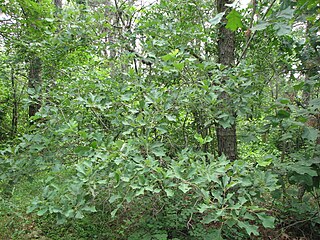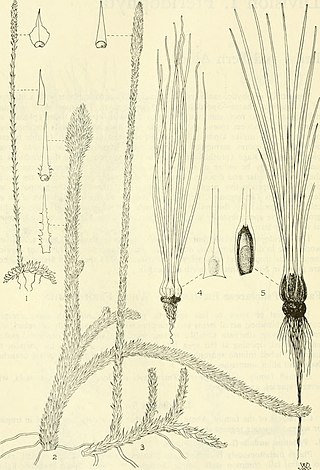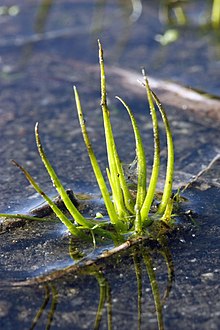
Isoetes, commonly known as the quillworts, is a genus of lycopod. It is the only living genus in the family Isoetaceae and order Isoetales. There are currently 192 recognized species, with a cosmopolitan distribution mostly in aquatic habitats but with the individual species often scarce to rare. Some botanists split the genus, separating two South American species into the genus Stylites, although molecular data place these species among other species of Isoetes, so that Stylites does not warrant taxonomic recognition. Species virtually identical to modern quillworts have existed since the Jurassic epoch, though the timing of the origin of modern Isoetes is subject to considerable uncertainty.

Isoetes lacustris, the lake quillwort or Merlin's grass, is a boreal quillwort native on both sides of the northern Atlantic Ocean. Synonyms include Isoetes hieroglyphica.

Arabia Mountain, a part of Arabia Mountain National Heritage Area, is the northern of two peaks in the Davidson-Arabia Mountain Nature Preserve, in DeKalb County, Georgia, United States. A low saddle separates it from Bradley Mountain, several hundred feet to its south. The two form a monadnock. The peak is 955 feet (290 m) above sea level, rising 172 feet (52 m) above Arabia Lake reservoir. Bradley Mountain is closer to the visitor trails than Arabia Mountain and is often misidentified by visitors as Arabia Mountain.
Eurybia avita, commonly called Alexander's rock aster, is a rare North American plant species, a herbaceous perennial in the family Asteraceae that was formerly considered part of the genus Aster. It is native to the southeastern United States. It is of conservation concern as it is found in less than 50 sites, typically only in sandy soils near granite flatrocks, and it is most likely already extirpated in North Carolina. Its habitat is threatened by development and the recreational use of the area where it grows. It is very similar to both E. surculosa and E. paludosa and more research needs to be done to determine the exact relationship between the three species.

Eurybia spectabilis, commonly known as the eastern showy aster, simply showy aster or purple wood aster, is an herbaceous perennial native to the eastern United States. It is present along the coastal plain of the U.S. where it is most often found growing in dry, sandy soils. Although it is not considered threatened due to its extensive range, it is locally endangered in many states. The flowers appear in the fall and show ray florets that are a violet-purple and yellow disc florets. It is one of the parent species of the hybrid Eurybia × herveyi.

Isoetes taiwanensis is a species of plant in the family Isoetaceae. It is endemic to Taiwan, and the only species of quillwort there. As other quillworts, it is relatively small, with erect leaves 7–24 cm (2.8–9.4 in) long. It grows submersed in shallow ponds for most of the year. IUCN considers it critically endangered because of habitat loss.

Isoetes engelmannii is a species of aquatic plant in the family Isoetaceae. It is referred to by the common names Engelmann's quillwort or Appalachian quillwort, and is the most widely distributed species of its genus in eastern North America. Its range extends from Ontario in the north, south to Florida and west Arkansas and Missouri. It can be found from April to October in temporary pools, bogs, marshes, stream edges, swamps and along wet roadsides.
Isoetes valida, commonly known as the strong quillwort or true quillwort, is an aquatic lycophyte native to eastern North America. It is found primarily in the Appalachian Mountains from Pennsylvania south to Alabama and Georgia. In addition, one collection of the plant was made in a railway ditch in Wilmington, Delaware in the 1860s, but this was most likely an accidental introduction.

Isoetes tegetiformans, commonly known as mat-forming quillwort or mat-forming Merlin's grass, is an aquatic lycophyte endemic to the U.S. state of Georgia. It grows exclusively in shallow, temporary pools on granite outcrops, often with only 2 cm of soil. Only 7 populations are known to exist, and three of these have been destroyed since the plant's discovery in 1976. The remaining populations are threatened with habitat destruction due to quarrying, though the species is protected under the U.S. Endangered Species Act. New leaves quickly sprout after fall and winter rains, but during the dry summer months these typically shrivel.

Quercus ilicifolia, commonly known as bear oak or scrub oak, is a small shrubby oak native to the Eastern United States and, less commonly, in southeastern Canada. Its range in the United States extends from Maine to North Carolina, with reports of a few populations north of the international frontier in Ontario. The name ilicifolia means "holly-leaved."
Isoetes eludens is an aquatic plant in the genus commonly known as quillwort that is native to the Kamiesberg Mountains in Namaqualand, South Africa. So far it is known to grow only in a single !gau (gnamma), a small temporary pool formed in a hollowed out area of granite rock. It has likely been growing in that region for millions of years, but was only discovered in 2007 and described in 2009. The specific epithet eludens refers to the fact that it eluded discovery, in spite of several searches in recent years in the area for new quillwort species.

Gratiola amphiantha is a rare species of flowering plant known by the common names little amphianthus, pool sprite and snorkelwort. It was previously the only species in the monotypic genus Amphianthus, but it was moved to genus Gratiola after genetic analysis in 2008. It is native to the Piedmont region of the southeastern United States, with a center of distribution in Georgia. It occurs in Alabama and South Carolina as well. It is limited to granite outcrops, a high-biodiversity habitat type that is threatened by activities such as quarrying, off-road vehicles, and trash and debris dumping. It is a federally listed threatened species.
Isoetes caroliniana, common name Carolina quillwort, is a wetlands plant native to the mountains of Tennessee, North Carolina, Virginia and West Virginia. It is an emergent plant found in lakes and bogs. It is closely related to I. georgiana but can be distinguished by its unpigmented sporangium wall.
Isoetes toximontana, the Gifberg quillwort, is a plant species native to the Northern Cape and Western Cape regions of South Africa. It is known from only 3 sites. The type locality is on the slopes of Gifberg, a mountain forming part of the eastern boundary of the Olifants River Valley. The name "Gifberg" means "poison mountain"; this is in reference to a poisonous tree called "gifboom", Euphorbia virosa, that is endemic to the area. The specific epithet "toximontana" is a Latin translation of the Afrikaans name of the mountain.

Isoetes echinospora, also known as spiny quillwort, spiny-spored quillwort or spring quillwort is a species of quillwort in the Isoetaceae family, and is the most abundant species in Canada. It can be found in shallow aquatic environments from Labrador and Newfoundland to Alaska, and south to Pennsylvania, Wisconsin, Michigan, Colorado, and California. In Germany it is found in only two locations: the Feldsee and Lake Titisee, both in the High Black Forest.

Isoetes butleri, commonly known as limestone quillwort, is a species of plant in the quillwort family, a member of the lycophytes.

Isoetes melanopoda is a species of nonflowering vascular plant belonging to the quillworts in the family Isoetaceae. Its common names include: black-footed quillwort, midland quillwort, and prairie quillwort.
Isoetes capensis, the cape quillwort, is a species of quillwort from South Africa.
Isoetes stellenbossiensis, the Stellenbosch quillwort or Cape Flats quillwort, is a species of plant from South Africa.
Isoetes stephanseniae, the granite quillwort, is a species of quillwort from South Africa, named for A. J. Stephansen, who discovered it in 1927. Of very limited distribution, it is known to survive only as one population in seasonal pools over granite near Stellenbosch, where it is threatened by the encroachment of alien species and eutrophication from the sewage works on whose grounds it grows. Like other quillworts, it bears a tuft of leaves with distinctively sculpted megaspores. It is most similar to Isoetes capensis, the cape quillwort, which occurs in the same province; both hold their leaves at a 45-degree angle, unlike most South African quillworts which have leaves stiffly erect.













